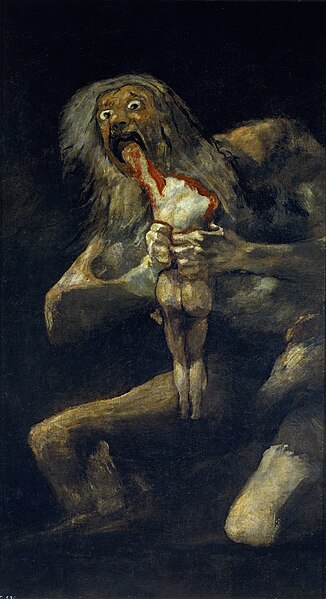
Title: Saturn Devouring His Son
Artist: Francisco de Goya
Date Painted: c. 1820 – 1823
Period: Romanticism
Dimensions: 143cm x 82cm
Medium: Mural Transferred to Canvas
Location: Museo del Prado, Madrid
Summary of Saturn Devouring his Son
Saturn Devouring His Son is one of Francisco de Goya’s most disturbing and powerful paintings, part of the series known as the Black Paintings. These were a group of artworks painted directly onto the walls of his house, the Quinta del Sordo (House of the Deaf Man), later transferred to canvas in the 19th century. Created between 1819 and 1823, during the later years of Goya’s life, these paintings reflect his disillusionment, despair, and perhaps his fear of madness. Unlike his earlier works, the Black Paintings were not commissioned but were personal works, never intended for public display.
Saturn Devouring His Son depicts the Greek myth of the Titan Cronus (Saturn in Roman mythology), who, fearing that he would be overthrown by one of his children, devoured each of them at birth. The painting is a horrifying scene that captures the moment of grotesque cannibalism with raw and shocking intensity. Saturn, wild-eyed and frenzied, grips his son’s body, tearing flesh from the body. The figure of Saturn is monstrous, more demon than god, his expression one of madness and desperation.
Goya’s use of chiaroscuro intensifies the horror, with stark lighting casting deep shadows over the scene, enhancing the dramatic and nightmarish quality of the painting. The background is murky and undefined, focusing the viewer’s attention entirely on the act of violence. The paint is applied in thick, hurried strokes, adding to the sense of chaos and frenzy.
The work can be interpreted in several ways. Some see it as a reflection of Goya’s fear of insanity or his commentary on the political turmoil and violence of his time, especially the horrors of the Peninsular War and the repressive reign of Ferdinand VII that followed. Others view it as a more personal expression of the artist’s anxiety over aging and obscurity or even as a metaphor for the destructive nature of time itself.
Saturn Devouring His Son is a striking example of Goya’s late style, characterized by its boldness, emotional intensity, and departure from conventional aesthetics. It stands as a testament to his genius in expressing the dark aspects of the human psyche and society. Today, this painting, like the rest of the Black Paintings, is housed in the Museo del Prado in Madrid and remains one of Goya’s most studied and renowned works, captivating and unsettling viewers with its primal intensity and haunting imagery.
The Legend of Saturn and his Children
The legend of Saturn (known as Cronus in Greek mythology) devouring his children is one of the most chilling tales from ancient mythology, symbolizing the cyclical nature of time, power, and fear of usurpation. According to the myth, Saturn was one of the Titans, the son of Uranus (the sky) and Gaia (the Earth). Uranus and Gaia prophesied that Saturn would be overthrown by one of his own children. To prevent this, Saturn consumed each of his children immediately after they were born, swallowing them whole to ensure they could never grow to challenge him.
This act of consuming his offspring is a literal interpretation of the fear of time (which Saturn represents) consuming all things. Saturn’s wife, Rhea, distressed by the loss of her children, tricked him when their youngest child, Jupiter (Zeus in Greek mythology), was born. She handed Saturn a rock wrapped in swaddling clothes, which he swallowed, thinking it was his son. Rhea then hid Jupiter away on the island of Crete.
Jupiter eventually grew up and, as the prophecy had foretold, challenged Saturn, leading to the Titanomachy, a war between the Titans led by Saturn and the Olympian gods led by Jupiter. Jupiter emerged victorious, freeing his siblings from Saturn’s belly by forcing him to regurgitate them. This victory established Jupiter and his siblings as the new pantheon of gods, with Jupiter as the supreme deity, thereby fulfilling the prophecy that Saturn had desperately sought to avoid.
The myth of Saturn devouring his children has been a potent symbol throughout history, representing the themes of power, destruction, and the inevitable cycle of life, where the old must make way for the new. This story has inspired numerous works of art, literature, and philosophy, reflecting the enduring fascination and horror at its core. Francisco de Goya’s painting “Saturn Devouring His Son,” part of his Black Paintings series, is one of the most famous and haunting interpretations of this myth, capturing the raw and terrifying nature of the act in a starkly personal and emotional rendering.